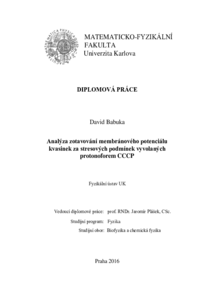Analýza zotavování membránového potenciálu kvasinek za stresových podmínek vyvolaných protonoforem CCCP
The analysis of membrane potential recovery in yeast under CCCP-induced stress
rigorózní práce (UZNÁNO)

Zobrazit/
Trvalý odkaz
http://hdl.handle.net/20.500.11956/97607Identifikátory
SIS: 199414
Kolekce
- Kvalifikační práce [10921]
Autor
Vedoucí práce
Fakulta / součást
Matematicko-fyzikální fakulta
Obor
Biofyzika a chemická fyzika
Katedra / ústav / klinika
Katedra makromolekulární fyziky
Datum obhajoby
9. 5. 2018
Nakladatel
Univerzita Karlova, Matematicko-fyzikální fakultaJazyk
Čeština
Známka
Uznáno
Klíčová slova (česky)
kvasinky, Saccharomyces cerevisiae, vnitrobuněčné pH, membránový potenciál, pHluorin, dis-C3(3), CCCP, stres, fluorescenceKlíčová slova (anglicky)
yeast, Saccharomyces cerevisiae, intracellular pH, membrane potential, pHluorin, dis-C3(3), CCCP, stress, fluorescenceDiplomová práce se zabývá studiem odezvy vnitrobuněčného pH kvasinkových buněk na různá vnější prostředí, především ve vztahu k protonoforu karbonylkyanidu m-chlorophenylhydrazonu, CCCP. K měření vnitrobuněčného pH kvasinkových buněk jsme využívali geneticky kódovanou fluorescenční sondu poměrový pHluorin. S využitím metody synchronně skenovaných fluorescenčních spekter jsme byli schopni měřit vnitrobuněčné pH buněk s vysokou přesností. Jako součást těchto experimentů jsme studovali také jak vliv iontové síly pufrů buněčných suspenzí na povrchový potenciál kvasinek, tak vliv anorganické soli KCl na depolarizaci membrán kvasinek a acidifikaci cytosolu vyvolanou protonoforem CCCP. Zkoumali jsme jednak přímo změny cytosolického pH a jednak jsme toto naměřené pH používali jako indikátor procesů a stavu prostředí mimo buňku. K nejvýznamnějším výsledkům této práce patří vyvinutí nové metody monitorování velikosti povrchového potenciálu kvasinek pomocí titračních křivek acidifikace cytosolu vyvolané protonoforem CCCP.
The master's thesis is focused on the study of response of the intracellular pH of the yeast cells on various external environments, primarily in a relation to the protonophore carbonyl cyanide m-chlorophenylhydrazone, CCCP. To measure the intracellular pH of the yeast cells we used a genetically coded fluorescent probe the ratiometric pHluorin. Using the method of synchronously scanned fluorescent spectra we were able to measure the intracellular pH of the cells with high precision. As a part of these experiments we also studied the influence of ionic strength of the cell suspensions buffers on the surface potential as well as the influence of the mineral salt KCl on the depolarization of the yeast membranes and cytosolic acidification induced by the protonophore CCCP. We examined the changes of cytosolic pH as such but we also used the measured pH as an indicator of the processes and the state of environment outside the cell. One of the most notable outcomes of this thesis is a new method of monitoring the value of the surface potential of the yeast cells by measuring the titration curves of cytosolic acidification induced by the protonophore CCCP.
